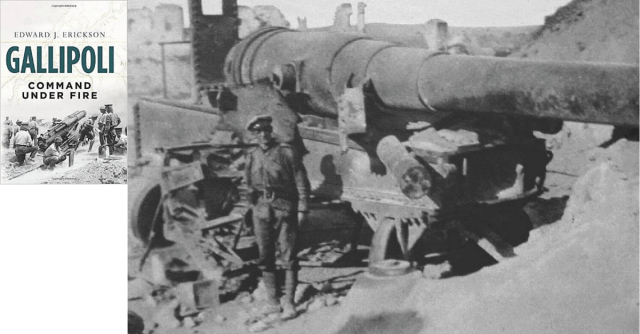Yes, there are many books about Gallipoli but by that same token there are many books about the Somme Campaign of 1916. So what? There is always room for more! Historians will keep writing about the Great War as long as there is public interest in the subject. American Lieutenant-Colonel, Dr Edward J. Erickson has produced a fascinating study of the Ottoman and British plans, operations and senior officers of the campaign. To quote from the book’s introduction, “The thesis of this book is that the Ottoman Army won the Gallipoli campaign because, at the operational level, its commanders demonstrated a more effective understanding and employment of command and control than its Allied adversaries.” Building on his Gallipoli The Ottoman Campaign (Pen & Sword, 2010) and his other work on the subject Erickson has produced another compelling book. Do not expect a pro-allied approach here, using excellent Turkish sources Erickson certainly pursues the Ottoman cause and good for him.
It is an interesting title because the command at Gallipoli, certainly that of the Allies, was and still is under fire. Divided into eight chapters that deal with the strategic setting, the plans, the early naval operations, men, arms and command structures, the landings and the counter operations, the Anzac operations in August and the end of the campaign. This well organised and accessible book has a good selection of maps and illustrations, excellent endnotes and bibliography.
He points out that when they took over both commanders, Liman von Sanders and Sir Ian Hamilton were able to build upon work and planning already done for defence and attack. Erickson’s main theme is that overwhelming force was not used by the Allies and I agree with him. The campaign was short of everything from the very beginning and the conclusions are not really surprising; this was, after all, an unwanted campaign. Erickson considers that Hamilton had a fragmented approach to his command and violated the principles of war; that is the “unity of command, mass, economy of force, simplicity.” On the other hand von Sanders was more aware of the situation, in possession of accurate intelligence and therefore was able to make effective decisions. According to Erickson that while the British Corps and Divisional commanders devolved executive command down to subordinate brigadiers and colonels, the British commanders were unable to deploy reinforcements and because of their position on the field and “reporting systems” they were unable to operate efficiently. Their Turkish counterparts operated more effectively because they knew their leader’s mind and were allowed to make independent decisions.
The final chapter, The Ending of the Campaign, 29 August 1915 – 8 January 1916, is a clear analysis of the end of the campaign and the factors that brought about the Allied decision to disengage. Just who was the most responsible for influencing the collective mind of the Allied leaders about the replacement of Sir Ian Hamilton and evacuation has been a moot point for years. It has been claimed that newsmen Keith Murdoch and Ellis Ashmead-Bartlett seriously influenced these events. While their views were aired to Prime Minister Asquith, Erickson demonstrates that other factors were already at work. In fact the British Government had been slowly coming round to the idea of replacing Sir Ian Hamilton and evacuating the Suvla base before the two reporters contacted the British establishment to express their opinions. Actually, one only has to read the Dardanelles Commission Report to realise that in early 1915 many powerful military and political figures in France and Britain were already against the prosecution of the whole enterprise.
In 1915 the allied governments thought that the Turkish forces would be a pushover. Turkey was, after all, to some contemporary observers, the ‘sick man of Europe’. How wrong could that notion be when it came to defending the Turkish homeland? There is a tendency to attribute the Turkish victory to German ingenuity and military skill. While there is no doubt about German and Austrian assistance this view demeans the ability of the Turkish forces, senior officers and command structure. Erickson’s book gives the Ottoman forces the credit they deserve for their emphatic victory at Gallipoli. As I like to say, this is a good read.
Reviewed by Dr Wayne Osborne for War History Online
GALLIPOLI
Command Under Fire
By Edward J. Erickson
Osprey Publishing, 2015
Hardback, 272 pages
ISBN: 978 1 4728 06697


